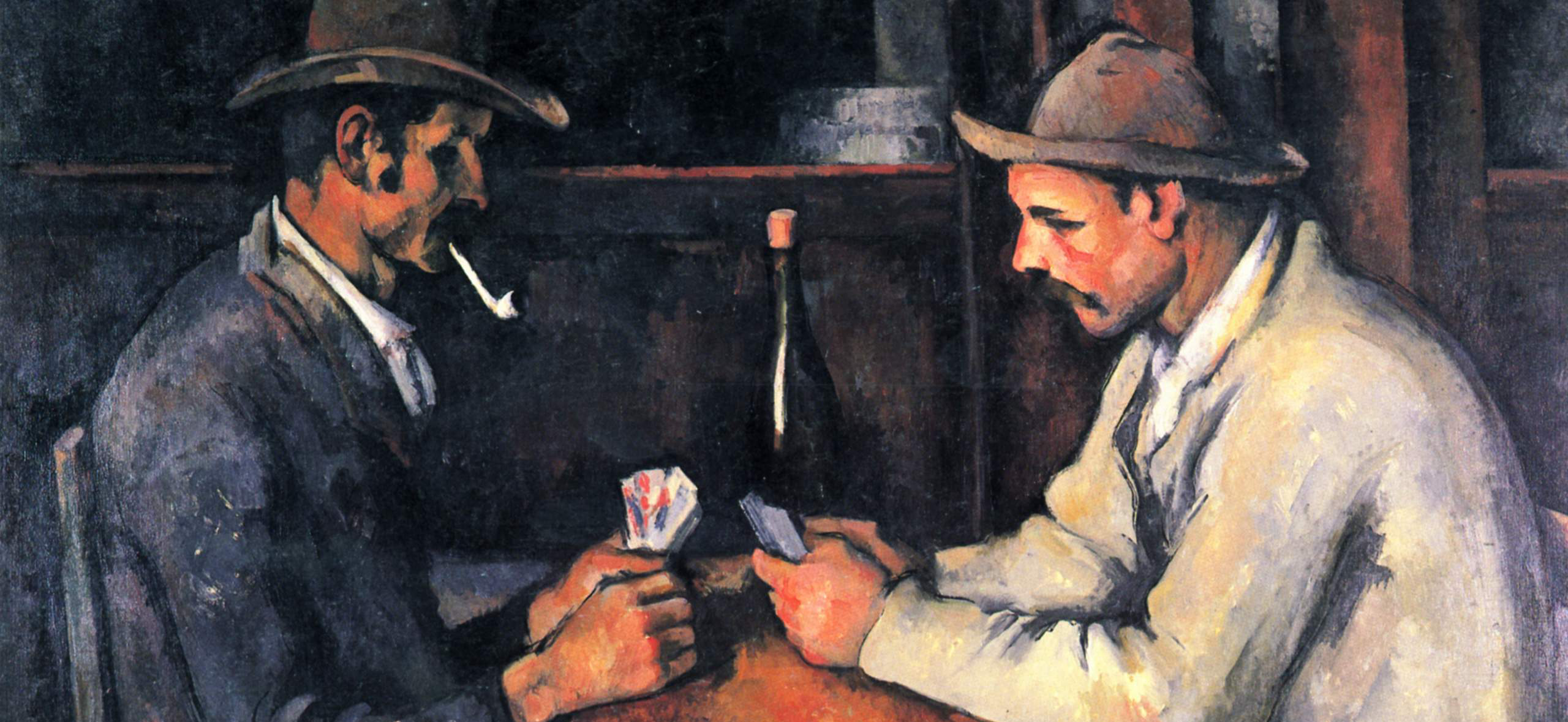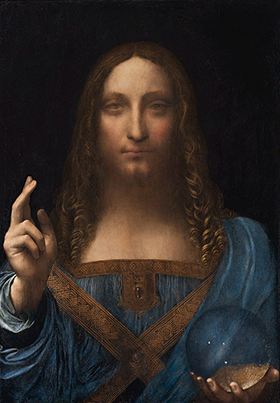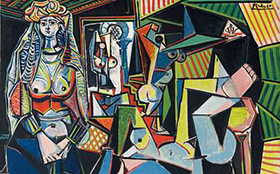Table of Contents
The 10 most expensive paintings ever sold1
- Salvator Mundi (c. 1500), Leonardo da Vinci – bought for $450.3 million in 2017 (adjusted for inflation and currency: £353.66 million)
- Interchange (1955), William de Kooning – bought for $300 million in 2015 (adjusted for inflation and currency: £210.80 million)
- The Card Players (1892/93), Paul Cézanne – bought for an estimated $250 million in 2011 (adjusted for inflation and currency: £182.47 million)
- Number 17A (1948), Jackson Pollock – bought for $200 million in 2015 (adjusted for inflation and currency: £140.53 million)
- Nafea Faa Ipoipo (1892), Paul Gauguin – bought for $210 million in 2014 (adjusted for inflation and currency: £136.23 million)
- Wasserschlangen II (1904-07), Gustav Klimt – bought for $183.8 million in 2013 (adjusted for inflation and currency: £125.83 million)
- Les Femmes d’Alger (1955), Pablo Picasso – bought for $179.4 million in 2011 (adjusted for inflation and currency: £125.13 million)
- Nu couché (1917/18), Amedeo Modigliani – bought for $170.4 million in 2015 (adjusted for inflation and currency: £121.68 million)
- No. 6 (Violet, Green and Red) (1951), Mark Rothko – bought for €140 million in 2014 (adjusted for inflation and currency: £120.62 million)
- No. 5, 1948 (1948), Jackson Pollock – bought for $140 million in 2006 (adjusted for inflation and currency: £98.33 million)
Why the crazy prices?
The list above shows what are currently the most expensive paintings ever sold. The following article, however, is an attempt to understand why; Why these particular paintings? Why these mind-boggling amounts?
Before researching this list, I – a cultural layman – naively expected to see a through-line where money met majesty, where wealthy art aficionados blew their fortunes on specimens of unmitigated genius, and where my own lack of knowledge would blossom into understanding and appreciation.
What I found instead was a sordid mess of crime, propaganda, economic perversity and some pretty crappy art.
Together, these ten paintings were sold for more money than the average Briton will earn in 1,403 lifetimes2. While that sinks in, let’s take a closer look at some of the factors behind the list.

The art of the con
Forget artistry, forget beauty, forget historical significance. There’s a very simple reason why some of these paintings went for such ridiculous prices. And, if you’re anything like me, it’s a reason that elicits a lovely warm glow of schadenfreude…
…the buyer got conned.
The world of high-end art dealing has always been a cesspit of forgeries, fraud and criminality. So it’s perhaps no surprise that the current list of most expensive paintings includes two sales that became part of one of the art world’s biggest scandals: the so-called ‘Bouvier Affair’.

Since 2003, Russian fertiliser magnate, Dimitry Rybolovlev, had been amassing a vast collection of high-end art bought via a Swiss art dealer, the eponymous Yves Bouvier. This relationship had seemed rosy, until 2015 when Rybolovlev accused Bouvier of overcharging him for purchases over a 10-year period. Since the paintings in question were some of the most sought-after in the world, the scale of the finances involved was staggering. According to Rybolovlev, Bouvier had inflated the prices on no less than 38 pieces he had bought through him, swindling the poor oligarch out of more than $1 billion in the process.
Both Klimt’s Wasserschlangen II and Rothko’s No. 6 (Violet, Green and Red), numbers six and nine on the list, respectively, were among these scam sales.
The case of the Rothko sale is a good example of how Bouvier operated. Rybolovlev was under the impression that he was buying the piece from French winemakers, Christian and Cherise Moueix, for the price of €140m with Bouvier acting as a middleman. It turned out, however, that Bouvier had actually bought the painting from the couple himself for a mere €80m some months before. Thus, after selling it to the unwitting Rybolovlev at an eye-watering mark-up of nearly 60%, Bouvier pocketed a cheeky €60m for his offshore account3.
Encompassing a series of ongoing civil and criminal proceedings in various countries, the Bouvier Affair has continued to snowball, shining a light onto the shadiness in all corners of the art world. Last year, for instance, Rybolovlev filed a suit against Sotheby’s, through which 12 of the 38 artworks were bought. Seeking $380 million in damages, he claimed that the venerable auction house had ‘instilled [Rybolovlev’s] trust and confidence in Bouvier and rendered the whole edifice of fraud plausible and credible’. A more recent twist saw Rybolovlev himself accused of multiple accounts of criminality for attempting to influence officials over the Bouvier saga.
With so many threads still playing out, it will be a long time before we reach the end of this saga. Although, as we shall see later, it hasn’t all turned out bad for the beleaguered Rybolovlev…

Propaganda, postmodernism and poor taste
You may have been expecting the world’s most expensive paintings to be dominated by classical styles – religious Renaissance art perhaps, or Turner’s atmospheric landscapes, or Van Gogh’s swirling colours. Instead, the most common style represented – taking up four of the top ten spots – is the idiosyncratic smears, squiggles and splats of Abstract Expressionism.
For many of us, the sight of De Kooning’s inane smears or Rothko’s simplistic blocks of colour induce bemusement rather than awe. But whereas a layman like myself might perceive only pretentious vacuity and facile mediocrity, those with vested interests (whether financial, cultural, or vocational) tend to see groundbreaking masterpieces and, of course, fat piles of money.

So how did such divisive scrawlings become some of the most coveted prizes in the history of art? The answer, or at least part of it, can be traced back to a covert propaganda campaign conducted by the US intelligence services.
Abstract expressionism ostensibly grew out of a rejection of post-war authoritarianism and conformity by left-wing American artists in the 1940s. Unsurprisingly, it was initially shunned by the establishment; derided for its simplicity and meaninglessness by cultural commentators and attacked by US politicians for its subversive intent by connecting it with the Cold War bogeyman of communism.
The CIA, however, saw something else in the burgeoning art movement – something they felt could help them win the cultural battle against the Soviet Union.
The predominant form of art in the USSR at the time was the rigid, state-sanctioned style of Socialist Realism. The CIA recognised that abstract expressionism, with its unorthodox, chaotic and ultra-subjective approach, was the antithesis of the Soviet style. But, even more importantly, it was American.
Thus, the CIA covertly set up and funded the Congress for Cultural Freedom to promote America – and abstract expressionism – as a beacon of artistic and intellectual liberty. As documented by many sources in recent years, the organisation was a “a vast jamboree of intellectuals, writers, historians, poets, and artists which was set up with CIA funds in 1950 and run by a CIA agent… At its height, it had offices in 35 countries and published more than two dozen magazines”.

Running for many years and costing millions of dollars, the campaign was a huge success, propelling the art style to the forefront of the world’s cultural landscape. Through its global network of proxies and agents, both witting and unwitting, the CIA funded various high-profile exhibits for abstract expressionist artists, the most prominent of whom became exceedingly rich and famous as a result.
Though still ignored by many, the CIA’s secret role in the promotion of abstract expressionism was made public decades ago. In the years since, this style, and the subsequent postmodern styles it influenced, have become staples of the world’s artistic output. Today, works by Rothko, Pollock and their modern imitators hang on the walls of government institutions, corporate offices, soulless hotels and overpriced restaurants the world over.
This is because the groundwork laid during the period of CIA propaganda – the academic intellectualising, the chin-stroking criticism, the hype, the celebrity, the money – has been taken up wholeheartedly by the contemporary art industry and its advocates4.
So, is the popularity of postmodern drivel all the fault of the CIA? Probably not. Are the exorbitant amounts of money paid for abstract nonsense a result of CIA propaganda? Almost certainly.

Cultural arms race of the Gulf states
40% of the buyers of the ten most expensive paintings are the filthy rich rulers (and their proxies) of Qatar and Saudi Arabia. For years these two rival states have been using their vast oil fortunes to amass huge museum collections of notable artworks and historic artefacts5. It’s all part of their ongoing public relations attempts to rebrand their countries as modern global cultural hubs.

Since coming to power in the mid-90s, aside from prising the country from the influence of Saudi Arabia, Qatar’s ruling Al Thani family have been hoovering up pricey artworks from across the globe. Three of the top ten list are Al Thani purchases – Picasso’s Les Femmes d’Alger, Gauguin’s Nafee Faa Ipoipo and Cézanne’s The Card Players – the latter of which smashed the previous art price record on its sale in 2011.
As many commentators have suggested, Qatar’s mission to create a ‘world-class’ art collection in such a short period of time has helped inflate prices across the industry. It’s not like they’ve been very discerning in their purchases either, buying and commissioning various pieces of crap from modern art’s most talentless hype-magnet, Damien Hirst, for example. This art splurge makes sense when you realise that Qatar needed to fill a glut of art galleries that opened in the capital, Doha, in the last decade – and the dozens more that are still being built.
Determined to not be outdone by their Qatari rivals, the Saudi royal family6 raised the stakes considerably in 2017 by making the most expensive art purchase in history. Not only did the Salvator Mundi purchase beat the existing record price by a staggering 50%, but it was also notable for another intriguing reason: it may not be a da Vinci painting at all.

There is no doubt that da Vinci did indeed paint the original Salvator Mundi sometime around 1500. Where this painting ended up, however, is somewhat hazy and further confused by the numerous copies made by the painter’s pupils.
What is known for sure, is that the current Salvator Mundi, then an overpainted ‘mess’ attributed to an unknown painter, was bought at a New Orleans auction in 2005 for just $1,000. After many years of restoration, reassessment and speculation the piece was shakily attributed to da Vinci. In 2013, it was bought by our old friend Yves Bouvier for $83 million. Who immediately sold it on to his bewildered chum, Dmitry Rybolovlev, for $127.5 million.
Luckily for Rybolovlev (see, I told you it didn’t all turn out bad for him), the Saudi royals decided to purchase the piece for their pals at the new Abu Dhabi Louvre for the record sum of $450.3 million. A bold move considering that the provenance of the painting was so dubious that the museum itself refused to exhibit it.
As pleasant as it is (in a ‘stoner Jesus’ kind of way), you might wonder why anybody would pay nearly half a billion dollars for a painting many believe is worth a tiny percentage of that?
Notwithstanding the fact that these are the same insane rich people that want to build a robot city in the middle of a desert, it makes perfect sense when you realise that it has been a hugely successful PR campaign for the new museum and for Saudi Crown Prince Bin Salman himself. Certainly makes for better headlines than his disgraceful war on Yemen, doesn’t it?

Inequality, financialisation and speculation
Ultimately, this list isn’t about the art, it’s about the money (that is why this article exists and probably why you are reading it, after all). For the ultra-wealthy who are doing the buying and selling, art is just a means to an end. Whether the art is being purchased as a vehicle for money laundering, for boosting a public image, or simply for financial speculation, the end is, essentially, always the same: more wealth (and, of course, the power which it confers).
The idea of art as investment has been around for a long time, but it received a calculated boost in the 1960s when the London Times newspaper teamed up with Sotheby’s to periodically publish an index charting price rises in art sold at auction. This wily piece of PR heralded the advent of art as a lucrative asset class, promising returns that could easily outperform traditional commodities.
In the decades since, the ‘art as investment’ trend has been breathlessly promoted by the corporate culture industries on one side and the parasitic financial industries on the other. These, together with the increasing global inequality that has made the super-rich super-richer, have resulted in ever more money being splashed out on art assets.

You can practically hear Deloitte’s money-men salivating in their biennial Art & Finance Report as they work themselves into a frenzy over big money stats: ‘With an estimated $1.62 trillion of UHNWI [ultra-high net-worth individuals] wealth allocated to art and collectables in 2016 and an estimated $2.7 trillion by 2026.’
With forecasts like that it’s not surprising that the financial industries have been falling over themselves to create new financial instruments – ‘innovative’ loan products, securitisation funds, derivatives, even blockchain technology – with which to further inflate and milk the financial potential of art.
But it’s not just the potential for profit that makes art a favourite investment for the rich and dodgy – it’s also the sector’s complete lack of regulation and transparency. Unlike just about every other item in the world, art can be bought or sold completely anonymously, there are no official registers of transactions or ownership. This makes art the perfect investment vehicle for the world’s increasingly wealthy elite. These are, after all, people who have expanded their fortunes by circumventing regulations that the rest of us flout at our peril.
So, billions of pounds being poured into a highly financialised, unregulated market, propped up by a sycophantic media and the world’s corrupt elite. What could possibly go wrong?
Well, as many commentators have pointed out, the speculative bubbles and crashes of the art market seem to mirror that of the wider global economy. Most pertinently, the art market was riding high with investments and record-breaking sales just before the Global Financial Crisis struck in 2008.
So, perhaps it should give us pause for thought that, when adjusted for inflation, nine of the current ten most expensive paintings were bought in the last 10 years. If we’re getting to the end of the current art bubble, then the coming pop may affect us all.
Notes
1. Data for this list was collated from various sources including Wikipedia, workandmoney.com and infoplease.com. Exact details for many purchases are unknown and thus based on estimations.
List is ordered by prices adjusted for inflation and converted to GBP currency as of publication date using historical currency converter on fxtop.com. Due to method this list is subject to fluctuation.
The list was compiled of single artworks only.
2. Based on the very basic assumptions of:
- Total value of paintings (adjusted for currency and inflation): £1,615,280,000
- Average UK salary 2018: £29,588
- Estimated duration of working life for a UK person who is 15 years old in 2017: 38.9
3. As someone who finds Rothko’s art laughably overrated, I find it quite fitting that a fertilizer tycoon, who made billions selling excrement, also spent his billions buying excrement.
4. The dribbles and daubs of abstract expressionism, much like the unmade beds and preserved sharks of postmodern contemporary art, are devoid of innate artistic merit. Therefore, in order to keep the money rolling in, many people are employed in endless attempts to give meaning to the meaningless – and to inform those of us who think it’s a load of crap that we ‘just don’t get it’ (they even employed scientists to ‘disprove’ the commonly held view that ‘a child could paint that’).
You only have to hear people praising this kind of work for its ‘delicate weft of insight, at once mystical, scientific and psychological’ or its ability to ‘provoke antithetical metaphysical responses’ once to realise the truth in the following statement by British anarchist writer, Darren Allen: ‘The pointless ugliness of contemporary art, the gladhanding venality of the art scene and the complete absence of sensitivity, intellect or originality in art criticism — in short the capitalism of the cultural industry — is usually disguised in a river of pseudo-intellectual pomo-babble’.
5. At least it’s a more respectable way to fill museums than the old ‘invade and plunder’ technique that many western countries used to employ.
6. Though initially unknown, the buyer was revealed to be a ‘lesser’ Saudi prince, Badr bin Abdullah bin Mohammed bin Farhan al Saud, but many now believe that he was acting as a stand-in for the real owner, the Crown Prince Mohammed bin Salman.




